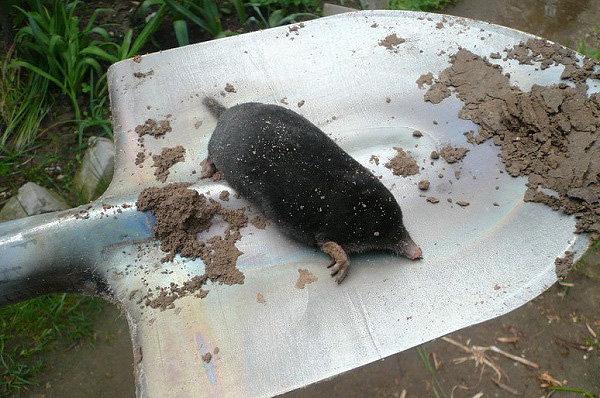
Next you will learn:
- Is it really possible to get rid of moles in a summer cottage by folk remedies;
- What is the optimal strategy to combat these animals and what important nuances should be taken into account;
- How can you effectively catch moles in the area using improvised means;
- Which folk means of scaring moles are the most effective, and which practically do not give a result;
- How to protect your site from the penetration of new pests and whether it is worth protecting the territory in winter.
In order to reliably get rid of moles at their summer cottage, expensive industrial manufactured devices for scaring away or catching animals are not always required - as practice shows, an excellent result can be achieved using simple folk remedies, it is only important to correctly approach the issue.
Among the methods and devices that were invented for independent control of moles in summer cottages, there are repellents, as well as means for catching animals alive (the so-called live-trap). Of course, not all of them are equally effective: we will talk more about these folk remedies in more detail and see which of them really work, and which ones are simply useless and even harmful.

On a note
It is important to understand that in most cases it will be possible to reliably get rid of moles in a summer cottage using folk remedies only with a well-planned integrated struggle. It is naive to believe that, for example, simply digging a dozen rotten heads from a herring into the underground passages of animals, or blowing up a couple of firecrackers in them, will thus be able to permanently solve your problem with moles - as practice shows, this can only work in one case of 10, and even then only for a short time.
Ideally, in addition to scaring away moles, it is also necessary to catch them and apply barrier means that will not allow the animals to get back to the site. Sometimes some of these components of success can be excluded (in particular, with good planning, you can do without scaring).
Also, summer residents often forget one simple thing: two different repellents are better than one, and three are better than two (the probability that moles do not immediately pay attention to three repellents is significantly lower than if only some one deterrent).
Unfortunately, many owners of summer cottages, worn out by wrecking moles, lose all compassion for these animals and are ready to mercilessly kill animals with almost bare hands or a shovel, and also use traps and other lethal and even sadistic devices (for example, to catch on fishing hooks).
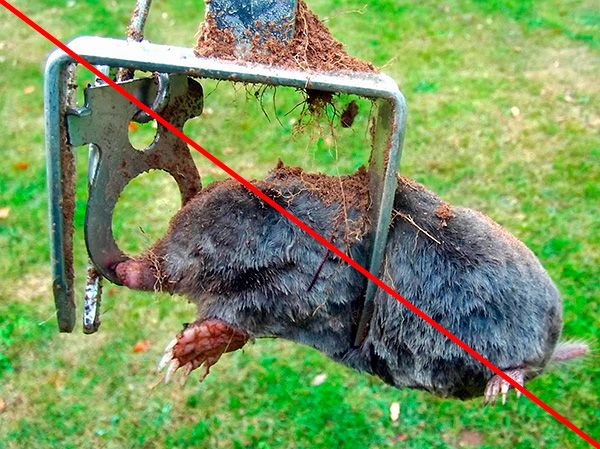
Such a negative attitude towards moles is most often caused by two reasons:
- Some summer residents are convinced that moles pretend to harvest them by eating carrots or potatoes (this opinion is wrong - moles eat insects, and various rodents spoil vegetables and roots of garden plants);
- Dislike of moles also occurs because they are forced to constantly lay new moves underground in search of food, while worsening the appearance of lawns and creating a risk for a person to twist his leg on it.
Well, in this case it is useful to keep in mind that using folk remedies you can get rid of moles without killing them. For example, you can scare away the animal or just catch it alive and take it away from the summer cottage, freeing it up.

Good to know
Sometimes, out of ignorance, shrews are also considered scary pests of the garden and try to get rid of them in every possible way.Meanwhile, these animals in large quantities destroy harmful insects and their larvae, do not lay significant underground passages and practically do not harm the garden. In other words, shrews are, rather, the active helpers of the gardener in the struggle for the crop.
Now let's see which of the folk remedies against moles are really effective and how to use them correctly.
General Mole Control Strategy
Perhaps the most reliable scheme for combating moles in the country with the use of folk remedies is as follows:
- Those animals that already exist in the summer cottage are captured, taken to a safe distance and released;
- At the same time, repellents are installed on the site during the installation of barriers;
- Barrage devices are installed that will prevent the moles from entering the garden again;
- After that, deterrents can be removed from the site.
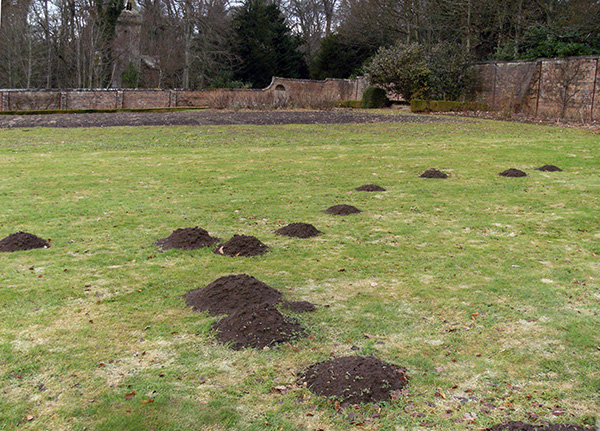
This scheme is good in that, firstly, moles are removed from the site immediately, without having time to cause additional damage, and the most time-consuming and expensive part of the procedure - the installation of barriers from moles - may not be performed immediately, but when the owner appears the opportunity to spend it.
With the full and correct implementation of this program, moles in the country will never appear again, even if there will be a lot of them around the site itself.
If any part of this scheme is canceled, then the result is not always achieved. For example:
- If you do not try to catch animals, but just scare them away. In practice, some repellers work well, for others - not very. It depends on the scarers themselves, and on the moles. Where the animals get used to the noise, bottles buried in the ground, and various turntables can no longer scare them away. Accustomed to the rustling of bushes, moles are not afraid of the same, for example, the reeds, which they sometimes try to use at their summer cottage as a folk repellent. In general, it is possible to limit oneself to repellers only, but the effect against moles is sometimes insufficient;
- If you catch moles, but start installing barriers only a month after that without using repellers, then there is a great risk that new animals will again populate the site over this month.
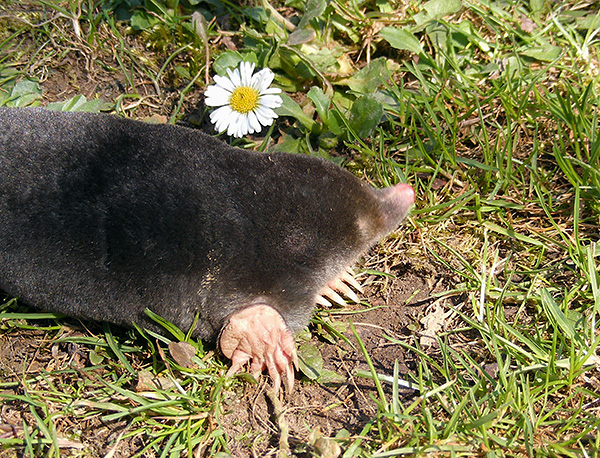
As a result, the main steps here are catching animals, which solves the problem “in the moment”, here and now, scaring away as an auxiliary measure, and installing barriers, which excludes the appearance of animals on the site in the future.
Let's first see what folk remedies will help to catch moles in the summer cottage.
Folk ways of catching moles
So, you can get rid of moles in the summer cottage by catching them using the so-called mole catchers (live-trap). For this purpose, the people widely use two main options for such designs:
- Catching in a makeshift "hole". The animal’s move is dug up, under it, a hole is dug into which a pre-selected deep pan, bucket, glass jar or plastic bottle with a capacity of 2 or 5 liters with a cut-off throat will fit. The edge of this trapping tool should be just below the bottom of the stroke. The container is placed in a pit, its edges are masked by rollers from the ground, and the entire excavated section of the course is covered with opaque material from above - a board, dense fabric or roofing material (so that light does not penetrate the course). At the next check of the course, the animal will fall into the trap and will no longer be able to get out of it;




- The mole is caught in a makeshift pipe trap. It is made of a two-liter plastic bottle, the bottom and neck of which are cut off, and “valves” are inserted instead of them, made of the necks of other bottles, directed towards the center of the main one. These necks are cut lengthwise into petals about 1 cm wide, which easily bend under the weight of the animal, letting it in, but then return to its original position and no longer allow it to get out.Also, a mole head pipe can be made from scraps of plastic or steel pipes - in this case, the valve is implemented according to the principle of a door that opens only inward. The mole trap is installed in the course of the mole and is covered with opaque material from above.


It is very important to choose the correct location for the mole traps: these traps must be set in the middle between the fresh heaps of land left by the mole.
The trap is checked 2-3 times a day. As soon as a mole is found in it, it is taken out of the course and the animal is carried away directly into it to release it. You can get a mole from a pit by putting on a tight construction glove on your hand.
On a note
Experienced mole cattle sometimes catch these animals, simply digging with a shovel. To do this, you need to trap the underground inhabitant (it is clearly visible when he moves in the course near the surface), quickly stick a shovel bayonet behind him and abruptly throw the earth with the animal itself onto the soil surface.
A mole on the surface of the earth can easily be caught by hand. At the same time, even if you have gloves on, it’s better to take the animal by the hair at the withers, between the head and back, so that it can not dodge and bite.
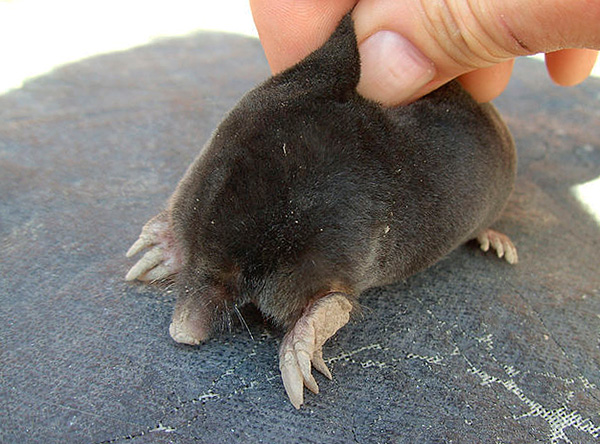
Also, the people know the barbaric way of catching moles with fishing hooks. In this case, a fishing line with 2-3 hooks is laid in the course (either a fishing tee is used), and its end is brought to the surface of the earth and attached to a solid pin stuck in the ground, or simply to a solid stick lying on the ground.
Sometimes worms are put on hooks (although this is not necessary), and bells are additionally hung on the pin. The mole, passing along, clings to the hook, that pierces his skin and digs into soft tissues. Trying to free himself, the animal pulls the fishing line, the bells ring and inform the catcher about the capture.
Depending on which part of the animal’s body the hook is screaming, the mole can get serious injuries and then die slowly, because this method, again, refers to inhuman and, one might even say, sadistic.
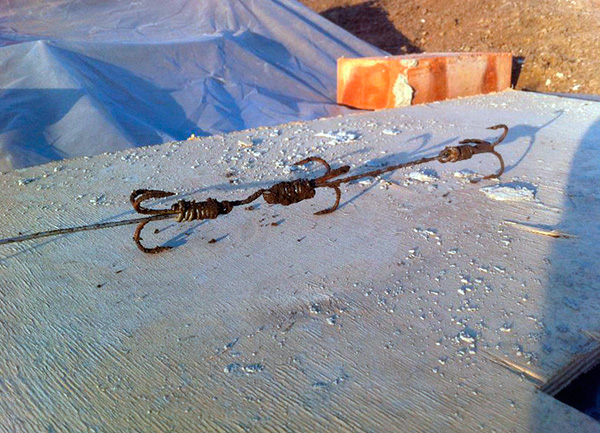

A note on inhumane ways to get rid of moles
In addition to various ways of catching animals alive, there are also folk remedies for the destruction of moles. For example, laying in the moves of earthworms cut in half or pieces of meat stained in rat poison. The method is inhumane and, in addition, ineffective, because thanks to the sharp scent, the mole recognizes the smell of poison quite well.
It is also sometimes advised to fill the burrows of moles with water from a hose, or place smoke bombs in them - insecticidal or sulfur. The first method is also ineffective, since many mole moves are filled with random landslides (the animal constantly clears them), and the water itself is quickly absorbed into the soil and does not flood the entire system of moves.
The second method is harmful to the soil and relatively ineffective: when it is used, a large number of soil microorganisms, insects and earthworms die, which bring great benefit to the garden. In addition, without forced injection, smoke is usually not able to fill any significant part of the underground passage system.
The molehill dog moles - dachshunds, fox terriers, yagd terriers help to get rid of moles well. For them, hunting for moles is their favorite pastime, and they can dig animals out of the ground. However, with such a hunt, the dog will dig a lot of holes, and there will be even more harm from it than from the mole itself.
But back to our molehills.
After catching a mole, you need to take it to a distance of at least one kilometer from the summer cottage and release it in a landing or in thick grass. In search of a convenient site, an adult animal almost never travels a kilometer long, but usually remains where it is released.

Mole must be released within 8-12 hours after capture.The fact is that due to the accelerated metabolism, this animal cannot starve for a long time, and usually within 24 hours after getting into the live trap it dies.
So, suppose that we could get rid of the moles available on the site. However, if no additional measures are taken, then his “colleagues” from the neighboring section will quickly penetrate into the liberated territory. Therefore, the next step is to prevent other animals from getting onto the site, and alternative means of scaring away moles may well contribute to this. We’ll talk about them ...
Folk remedies for scaring away moles
Perhaps it is immediately worth noting that the effectiveness of folk means of scaring moles off the site is not absolute: they work every other time, and sometimes they turn out to be completely useless. Veste, however, in some cases, the effectiveness of certain funds is very well expressed, and they really allow you to quickly get rid of moles in the country.
To begin with, we will consider some commonly used folk methods of scaring away moles, based on sound effects:
- Mole repellers made from plastic bottles or beer cans are the so-called “turntables”. In bottles (banks), the blades are cut out and bent, and the resulting kind of windmill is installed on the stuck metal pin. In the wind, the structure spins, while plastic or tin emit sounds that scare away the animals. However, such repellers do not always help get rid of moles - they help someone to drive out pests from the site every season, and for others, animals dig passages right under the pins;



- Bulrush, whose stems stick directly into the moves of animals. It is believed that moles are scared away by the hum of the stem in the wind, which, however, is doubtful;

- Empty glass bottles that are instilled into the ground at an angle of about 45 degrees so that their necks stick out at a height of 5-10 cm above the ground. The wind, blowing into the bottle, emits a rumble transmitted from glass to the ground, and many summer residents believe that this rumble scares moles. In practice, the method rarely works;

- They also sometimes try to get rid of moles with the help of plastic bottles that are simply scattered around the site and hermetically sealed with lids. It is believed that the crackle emitted during bottle deformation due to temperature changes during the day scares away moles.

You can try to use all these folk “noise-makers” by combining with each other, but there is no guarantee that they will work. In any case, to place these funds is more or less evenly distributed over the site, so that the mole at any point hears the sound of a repeller.
It is interesting
Of course, folklore also gave rise to numerous curious means of scaring away moles. For example, it is advised to regularly turn on loud music in the area during the day, preferably heavy (with a predominance of low frequencies), which the moles supposedly cannot tolerate. How to relate to such methods is up to the summer resident (as well as his immediate neighbors) to decide.
Separately, it is worth considering popular folk remedies that sometimes allow you to drive moles from their summer cottage with the help of a smell. The following methods are recommended for this:
- Laying in the passages of the animal rotten fish and meat, rags drenched in kerosene, gasoline, white spirit or vinegar. Someone strongly recommends using human excrement or, at worst, urine in cats for this purpose. Interestingly, each of such measures did sometimes help people get rid of moles, and most often rotten fish heads are used with a positive effect. However, there are also frequent cases when an animal isolates odorous moves and starts digging new ones intensely, and the result is the opposite of what is desired — even more molehills appear on the site;

- Laying a small open container with ammonia along with a firecracker in the moves.At the same time, it is advised to cover the firecracker with a pan before the explosion to enhance the effect, so that the smell of ammonia under the pressure created by the explosion spreads far along the animal’s moves. Two points should be taken into account here: this method of getting rid of moles is not far from livestock breeding (ammonia is a combat poison gas that was sometimes used during military operations) and, in addition, ammonia is too volatile and will quickly disappear from underground tunnels;

- Placement of bean plants and hemp in the underground passages. There is a popular opinion that the mole does not tolerate the smell of these plants. However, this assumption is rarely confirmed in practice;

- Laying carbide in the moves. When interacting with the moisture of the earth, carbide releases acetylene mixed with phosphine. Phosphine, even in very low concentrations, has a specific unpleasant odor, which is supposed to repel moles. Sometimes this method really works.


It is interesting
In attempts to drive moles from the site, odors also can not do without oddities. So, for example, as already noted above, there is an opinion that moles are scared away by the smell of urine. As a result, there are cases when people for weeks collected urine in a bucket from their entire family, which they then diligently poured into moves ...
Sensible summer residents need to keep in mind that the mole is an animal not prone to long-distance movements. Plus, you won’t especially accelerate underground, and other moles live on the borders of its territory, who are not at all eager to meet a refugee from urine or hard rock at their place (when they meet each other, moles can seriously mutilate and kill each other - these are single animals jealously guarding their possessions).
Therefore, in order to really leave the habitable area, the mole must have a very good reason. Excrement, the rustling of reeds or rotten fish in its moves are far from always able to move the animal on such a voyage.

Speaking of smells, it’s also worth remembering the cultivation of garlic, onions, caper milk, marigolds, imperial hazel grouse and black beans along the borders of the plot. There is evidence that moles are scared away by the smell of the underground parts of these plants. However, the effect is not always observed.
So it’s especially not worth relying on scaring moles folk remedies, although it is quite possible to test. A more effective approach is to erect a fence as early as possible. Rather, bury it in the ground ...
Protecting the site from animal penetration
There are two really very reliable ways to prevent the entry of moles into the summer cottage:
- Around the entire perimeter of the site, a metal mesh with a mesh of 1-2 cm, not more than (or a strong plastic mesh) is buried in the ground at a depth of 50-80 cm. It is desirable that its top protrudes 10-20 cm above the surface of the earth. This is an insurmountable barrier to the mole. Theoretically, he can dig a move under this grid, but almost never does it;

- Or, a tape foundation with a depth of 50-60 cm is made along the entire boundary of the site in the ground. Fact: in moles completely surrounded by a fence with such a foundation, moles never appear.

It is clear that such work is very time-consuming and expensive, but in general they are usually carried out not only to fight moles, but also to improve the site (to install a fence, to prevent flooding or soil movements). Therefore, if there is an opportunity to do this, then you need to do it: when the neighbors cry about the fact that their entire area is pitted with moles, you will already forget how the traces of the vital activity of these animals look.
Is it worth protecting the site in winter?
In winter, the mole does not hibernate, becoming only slightly less active than in the summer, but as a whole digs a lot of new moves due to lack of food. This means that with some probability the animal can penetrate the site at this time of the year. Therefore, if in the summer and in the fall one or another folk means of repelling really worked well, then in the winter they also need to be left at the cottage, and if necessary, regularly updated.
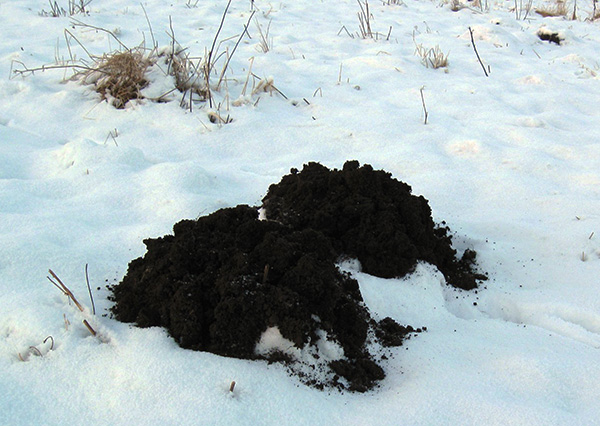

In addition, it is in the winter in the garden of the mole that it is easiest to catch with a shovel or live-trap.
As you can see, getting rid of moles in a summer cottage by folk remedies is quite possible, and for this it is not necessary to kill animals. Of course, such a struggle will require a certain amount of time and effort, but if the work is carried out correctly, it will allow removing pests forever with a clear conscience.
If you have your own experience in fighting moles in a country house or garden, be sure to leave a review at the bottom of this page - maybe someone will help him make the right decision when choosing one or another remedy.
An interesting video about the fight against moles on the site using a mole head pipe
Practical information about mole and mouse repellers

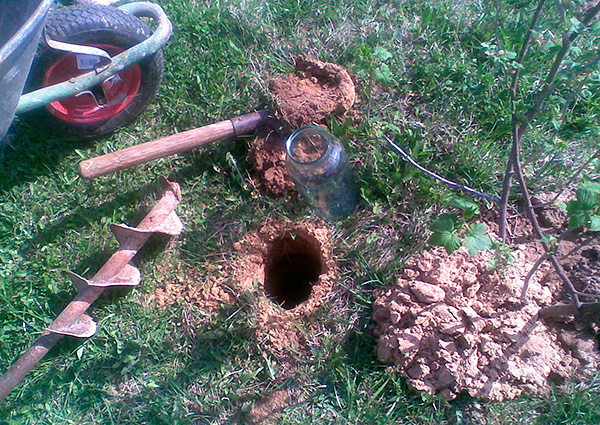
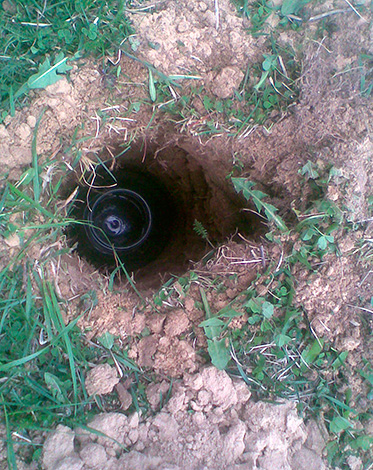
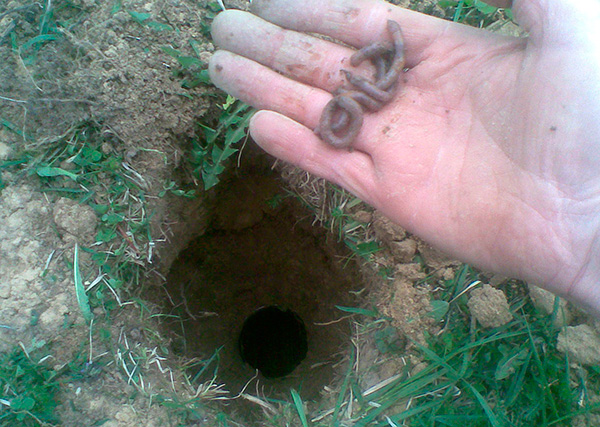
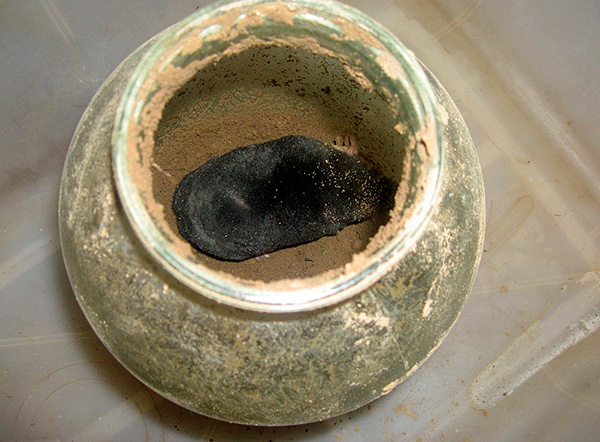

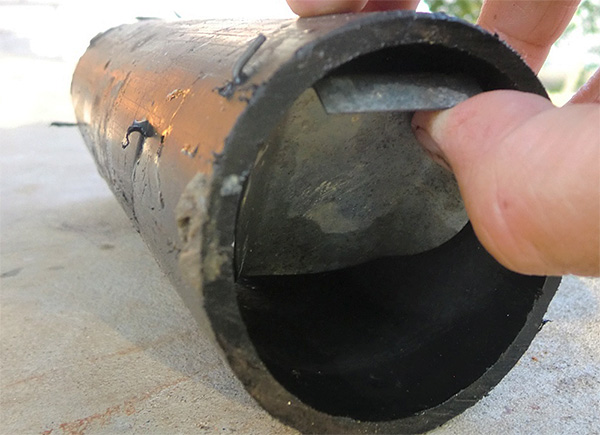
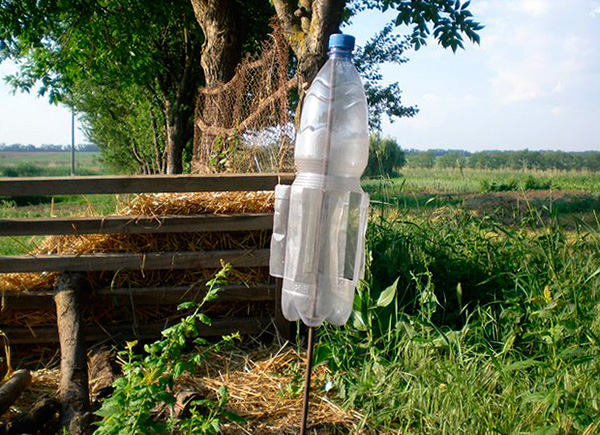


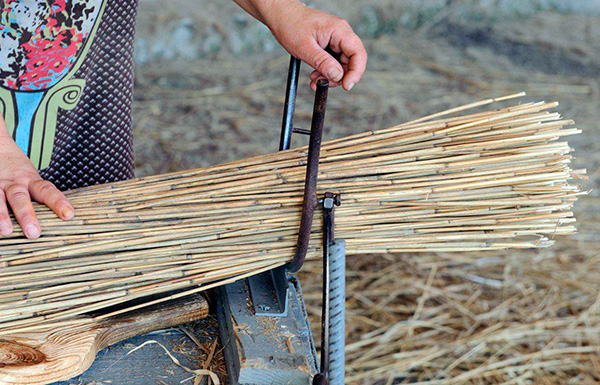
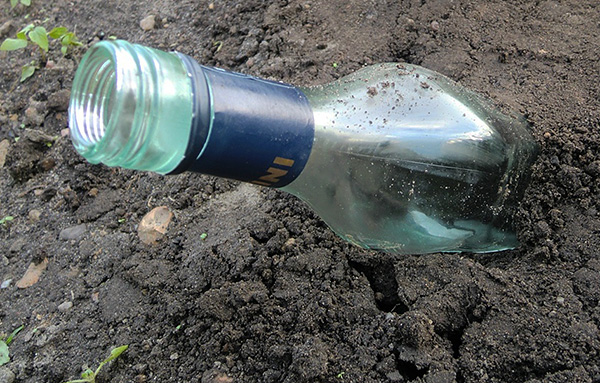




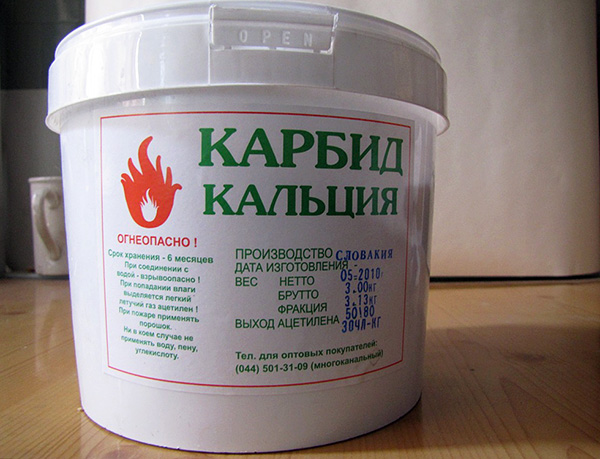
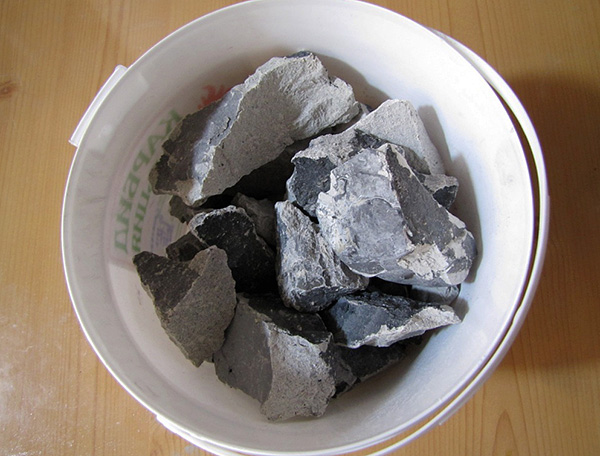





My site is flooded in the spring, so this prompted me to think of natural protection from moles by wet ditches (in summer). There are almost no moles, although all the neighbors have been fighting for decades, including deterrents. Moles do not like wet ground.
How to get rid of moles? We have a lot of them.
Read the article, damn it.
And try to invite the author of this “smart” article and the humanist to come and pick up moles for yourself. And then he himself does not have a meter of land, but he loves animals.
The strip foundation - smiled)) I have a plot of 30 acres ... Presented the Great Wall of China.
Call in to the site by car, take a hose from an old vacuum cleaner or something similar. One end into the exhaust pipe, the other into the mink. 20 minutes of idling - and a calm summer is provided for you. In the process, they can begin to crawl out of the mink - catch it, or a shovel to help you. Inhumane, but effective.
And if you put propane in a mink from a cylinder, how much does it affect moles?
You take a Chinese gas can with a piezo nozzle for soldering. You open for 1 minute, inserting the nozzle into a fresh mole, and press the trigger. The effect of military Pinocchio. But not too close to residential buildings.
I got rid of moles with the help of White Spirit. I abundantly soaked the rags, put them in all the minks that I found on the site, and dug the minks. 2 years did not even remember moles. Last year, moles again “glanced” at my site. I repeated the procedure with White Spirit - the effect is the same (moles are gone). And for all the scarers that I put initially, my moles did not care.
And where can I get the White Spirit?
White spirit is sold at hardware stores or at paint stores. It serves as a solvent for paints.